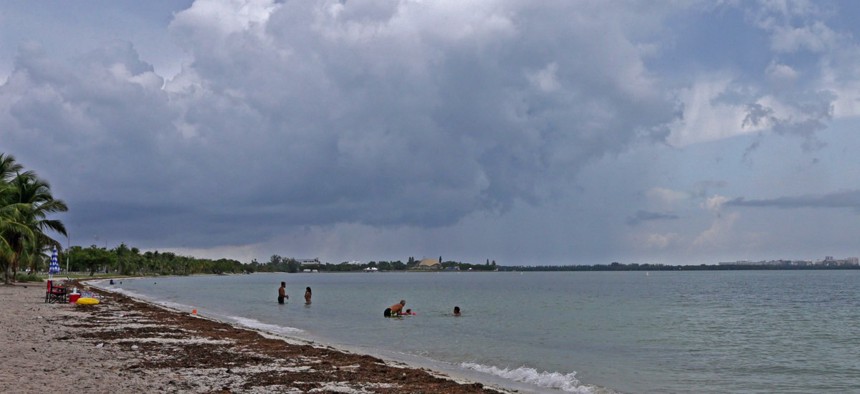Tropical Storm to Bring Heavy Rain to Florida; Will Baltimore’s Drug Problems Alter Local Aquatic Life?

Hobie Beach in Miami Alan Diaz / AP Photo

Connecting state and local government leaders
Also in our State and Local Daily Digest: Tulsa’s gonorrhea and chlamydia hot spots; Confederate T-shirt courtroom dispute in South Carolina; Indiana’s ‘Grave in the Middle of the Road’
TAMPA, FLORIDA
EMERGENCY MANAGEMENT | While Tropical Depression Nine isn’t expected to grow into a full hurricane, the storm system that’s currently moving away from Cuba into the Gulf of Mexico is expected to curve to the northeast and bring torrential downpours to parts of Florida as a tropical storm later in the week. The Tampa Bay area could see some storm surge associated with the storm. [Tampa Bay Times; National Hurricane Center]
BALTIMORE, MARYLAND
ENVIRONMENT | Water-quality tests of the Gwynns Falls watershed in Baltimore is turning up a mix of pharmaceuticals and illegal drugs, including morphine, which can be a byproduct when heroin is ingested. While any would-be addict couldn’t get high from drinking Gwynns Falls waters, the substances have a high enough concentration to have an impact on the local aquatic ecosystem. “We understand how they got there, but once they’re there we don’t understand what they do,” said a co-author of a recent study into the matter. Also in the waters of Gwynns Falls: caffeine, antihistamine, and acetaminophen. [Bay Journal via Baltimore Brew]
TULSA, OKLAHOMA
PUBLIC HEALTH | Certain ZIP codes in the Tulsa area have rates of gonorrhea and chlamydia far higher than the national average, according to new data from the Tulsa Health Department. In 2013—the most recent data that’s available—Tulsa County had a gonorrhea rate of 200.5 per 100,000 people, almost double the national average, with two ZIP codes with rates between 464.9 to 1,000.3 per 100,000 people. For chlamydia, Tulsa’s overall rate was 545.5 per 100,000 people—the national average was 446.6 per 100,000 people—but the same two ZIP codes ranged from 1,149.1 to 1,892.4 per 100,000 people. Some good news on the syphilis front: Tulsa’s rate is below the national average though one ZIP code had a rate six times the national average. “It’s surprising to see just how bad things are looking in these particular areas,” said one local doctor. [Tulsa World]
YORK COUNTY, SOUTH CAROLINA
CONFEDERATE FLAG | A prospective juror sporting a Confederate flag T-shirt with the slogan “If this flag offends you, you need a history lesson,” was cleared by a judge to serve on a jury here, despite objections from a defense lawyer—the only person of color participating in the trial. The case ended in a plea deal, so the jury was not needed. The Confederate battle flew at the South Carolina Statehouse for 54 years, but came down last year after nine black people were murdered at a church in Charleston. To many people the flag is a symbol of racism, but others contend it is a part of their heritage. “To me, it was problematic – not just the flag, but the message,” said the lawyer, Monier Abusaft, who is a public defender. [The State]
GREENWATER, WASHINGTON
PUBLIC LANDS | For gun enthusiasts, many areas of national forest land can be a refuge for target practice, as long as certain precautions are taken, including staying at least 150 yards from campsites and occupied buildings and ensuring that shooting doesn’t put anyone in danger. But east of Seattle in the Mount Baker-Snoqualmie Forest, residents in the Greenwater area are fed up with nearby public lands being an epicenter for people with guns, who have littered the ground with shotgun shells, metal jackets and destroyed targets, including iPhones, propane bottles and aerosol cans. Recently, exploding targets started a small wildfire. “There’s garbage everywhere and toxic chemicals,” one resident said. [The Seattle Times]
JOHNSON COUNTY, INDIANA
GRAVES | Lanes will reopen around the “Grave in the Middle of the Road” on Friday. The burial site, an Indiana landmark, has been in the center of what is now County Road 400 South since 1831. Nancy Kerlin Barnett’s last request was to be buried on a hillside there. In 1905, when county officials planned to move the grave to build the road, her grandson defended the site with a shotgun, and workers built lanes on either side of it—or so the story goes. Some of Barnett’s kin were buried there as well. Over the last four months, the highway department in Johnson County, located south of Indianapolis, worked with archeology students and a local museum to improve the road and to preserve the grave. Over the years it had been the site of traffic mishaps, and had been marred by passing farm equipment. [The Indianapolis Star]

NEXT STORY: Electronic tolling set go live in Massachusetts




